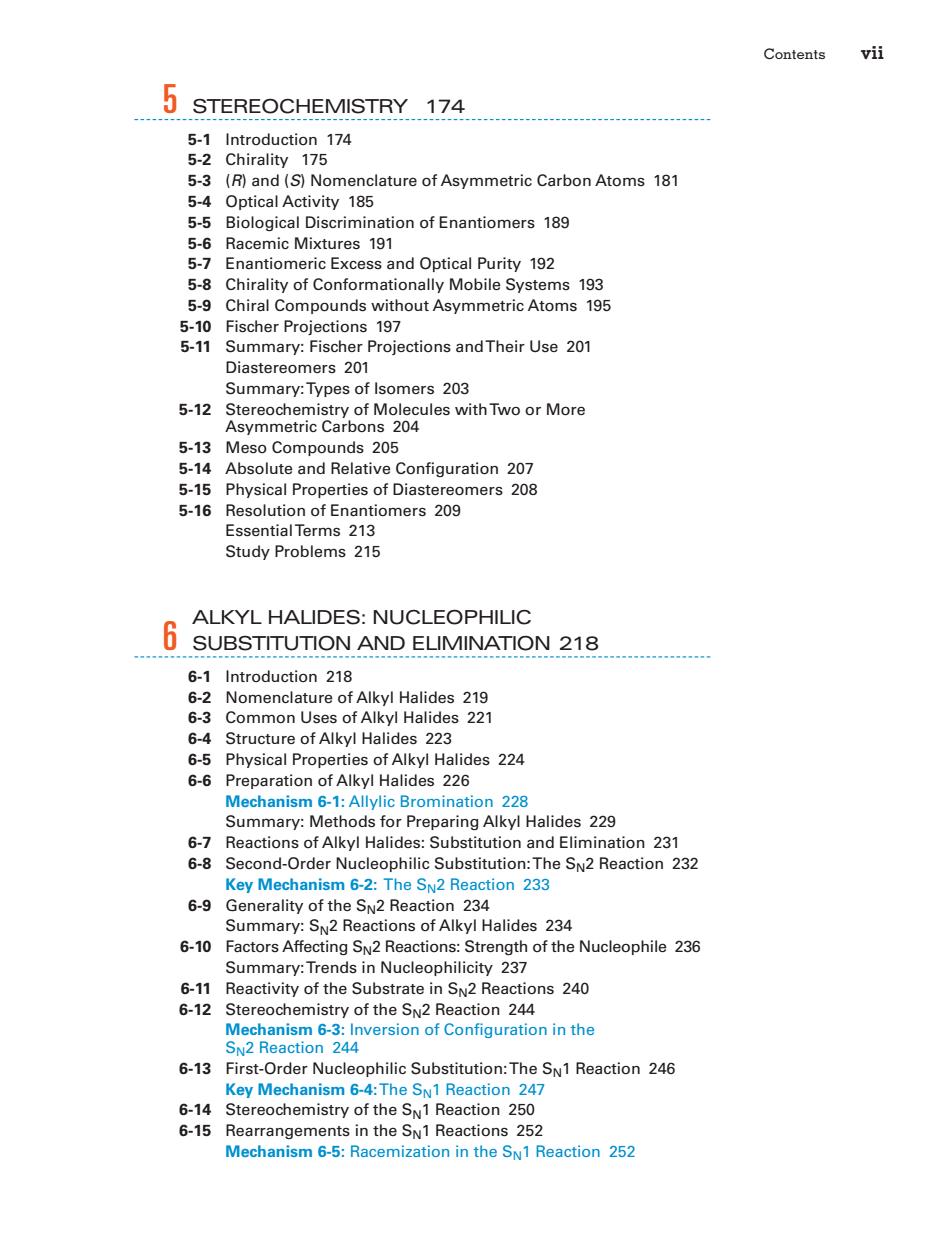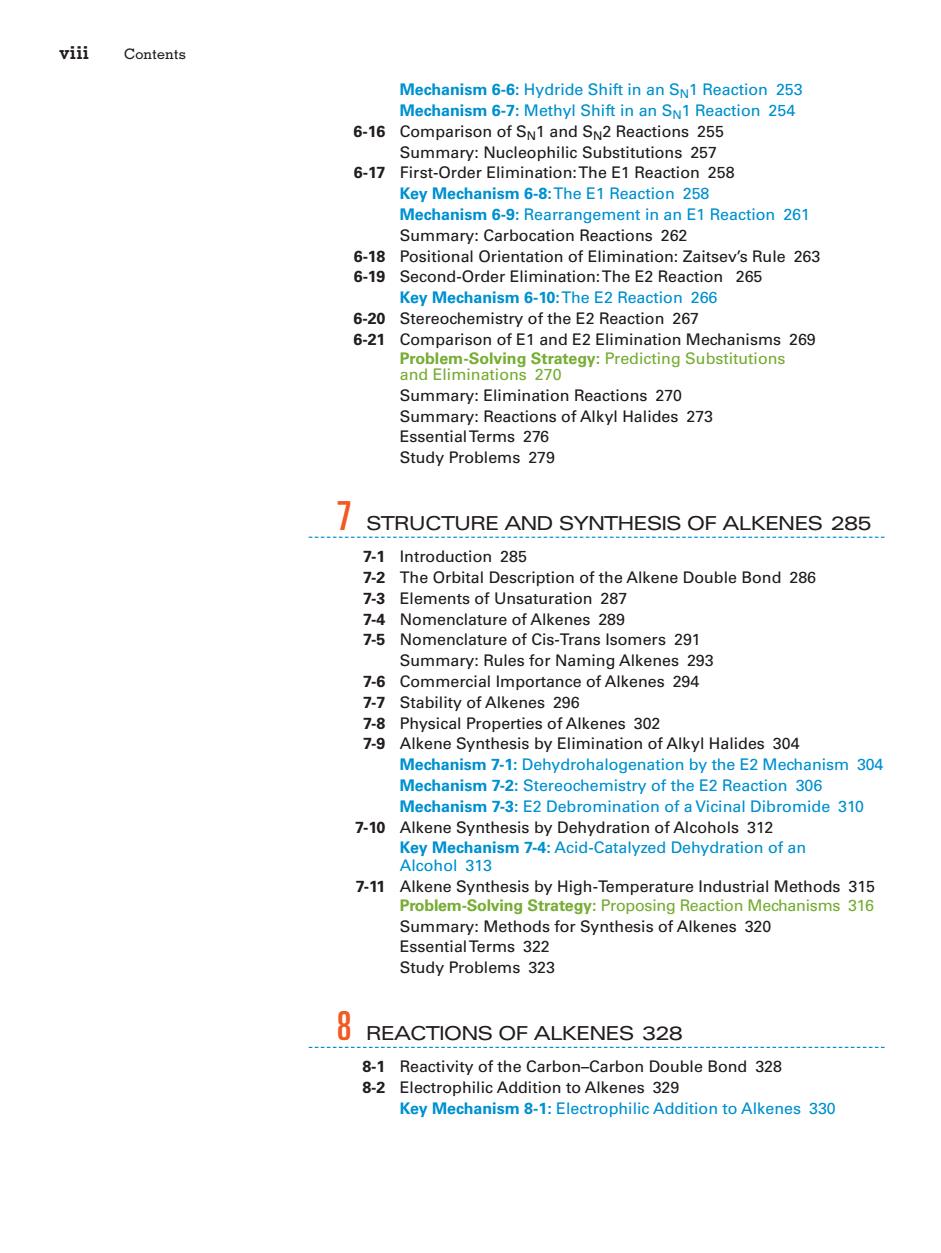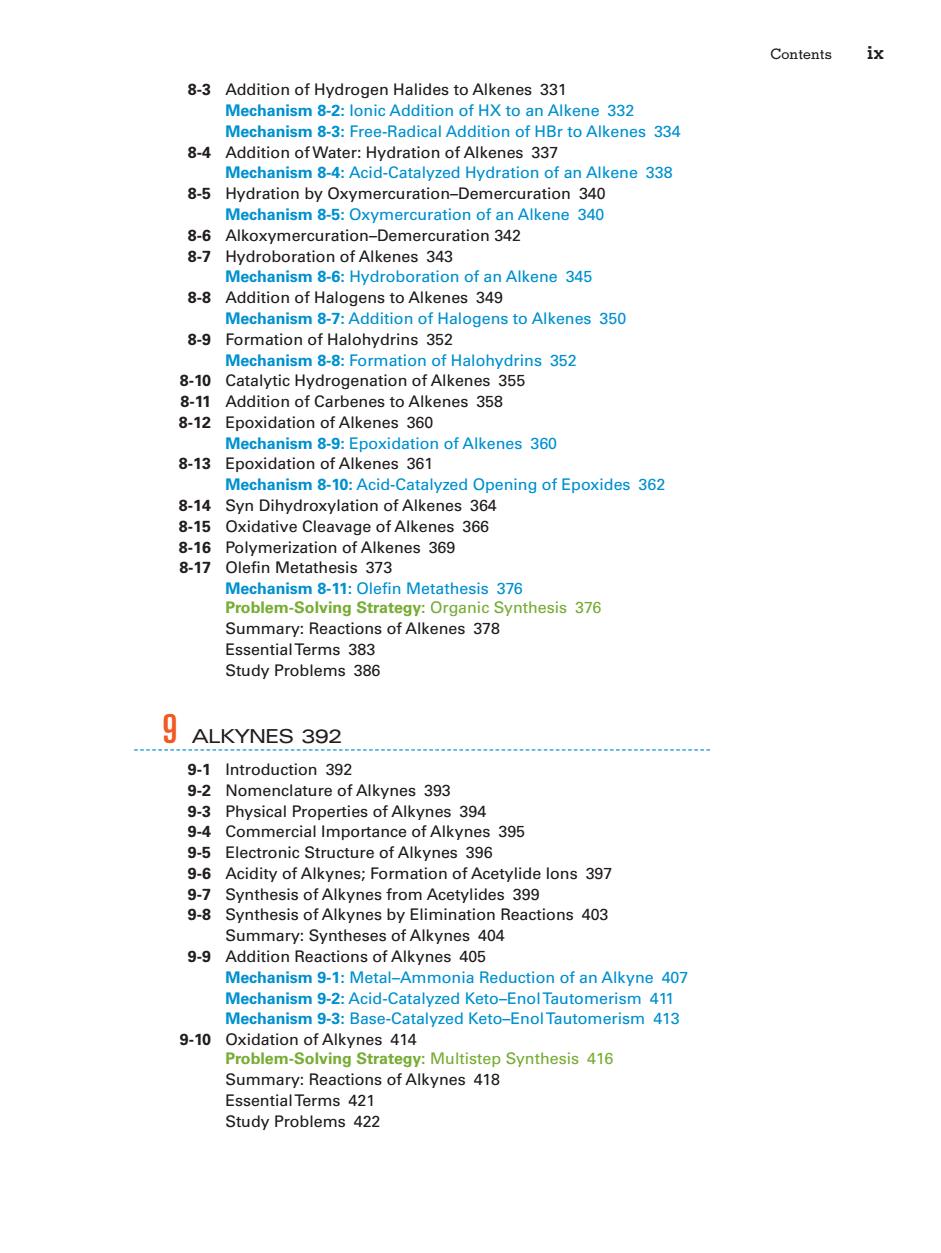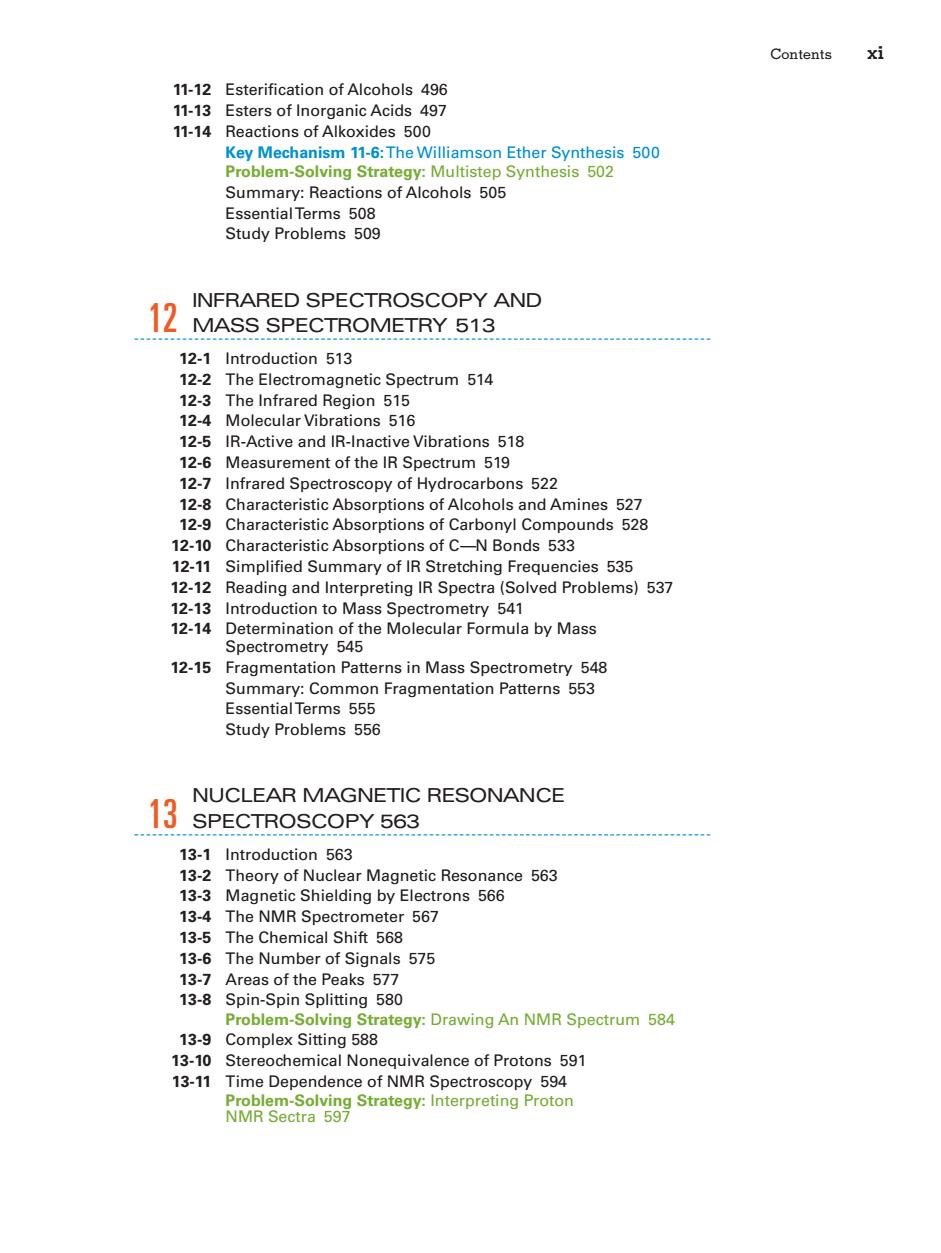
Contents vii 5STEREOCHEMISTRY174 5-1 Introduction 174 5-2 Chirality 175 5-3 (R)and(S)Nomenclature of Asymmetric Carbon Atoms 181 5-4 Optical Activity 185 5-5 Biological Discrimination of Enantiomers 189 5-6 Racemic Mixtures 191 5-7 Enantiomeric Excess and Optical Purity 192 5-8 Chirality of Conformationally Mobile Systems 193 5-9 Chiral Compounds without Asymmetric Atoms 195 5-10 Fischer Projections 197 5-11 Summary:Fischer Projections andTheir Use 201 Diastereomers 20 Summary:lypes o me 20 5-12 ules with Two or More 20 5-13 Meso Compounds 205 5-14 Absolute and Relative Configuration 207 5-15 Physical pronerties of diastereomers 208 5.16 Resolution of Enantiomers 209 Essential Terms 213 Study Problems 215 ALKYL HALIDES:NUCLEOPHILIC 6 SUBSTITUTION AND ELIMINATION 218 Introduction 218 ommon Usp kyl Hali kyl Ha 6.5 6-6 rope lides 224 d Halid s22 6-1:Allylic Summ ds for Alkyl Halides 229 6.7 s of alkyl Halides .c. ituti and Eli tion 231 6-8 Second order Nu cleophilic Substitution:The S2 Reac tion 232 Key Mechanism 6-2:The SN2 Reaction 233 6-9 generality of the sn2 reaction 234 Summary:SN2 Reactions of Alkyl Halides 234 6-10 Factors Affecting SN2 Reactions:Strength of the Nucleophile 236 Summary:Trends in Nucleophilicity 237 6-11 Reactivity of the substrate in s2 reactions 240 6-12 Stereochemistry of the SN2 Reaction 244 Mech anism 6-3: nversion of Configuration in the 6-13 ophilic Substitution:The SN1 Reaction 246 e A. on 6-14 6-15 the 25 65.R Reaction 252
Contents vii 5 STEREOCHEMISTRY 174 5-1 Introduction 174 5-2 Chirality 175 5-3 (R) and (S) Nomenclature of Asymmetric Carbon Atoms 181 5-4 Optical Activity 185 5-5 Biological Discrimination of Enantiomers 189 5-6 Racemic Mixtures 191 5-7 Enantiomeric Excess and Optical Purity 192 5-8 Chirality of Conformationally Mobile Systems 193 5-9 Chiral Compounds without Asymmetric Atoms 195 5-10 Fischer Projections 197 5-11 Summary: Fischer Projections and Their Use 201 Diastereomers 201 Summary: Types of Isomers 203 5-12 Stereochemistry of Molecules with Two or More Asymmetric Carbons 204 5-13 Meso Compounds 205 5-14 Absolute and Relative Configuration 207 5-15 Physical Properties of Diastereomers 208 5-16 Resolution of Enantiomers 209 Essential Terms 213 Study Problems 215 6 ALKYL HALIDES: NUCLEOPHILIC SUBSTITUTION AND ELIMINATION 218 6-1 Introduction 218 6-2 Nomenclature of Alkyl Halides 219 6-3 Common Uses of Alkyl Halides 221 6-4 Structure of Alkyl Halides 223 6-5 Physical Properties of Alkyl Halides 224 6-6 Preparation of Alkyl Halides 226 Mechanism 6-1: Allylic Bromination 228 Summary: Methods for Preparing Alkyl Halides 229 6-7 Reactions of Alkyl Halides: Substitution and Elimination 231 6-8 Second-Order Nucleophilic Substitution: The SN2 Reaction 232 Key Mechanism 6-2: The SN2 Reaction 233 6-9 Generality of the SN2 Reaction 234 Summary: SN2 Reactions of Alkyl Halides 234 6-10 Factors Affecting SN2 Reactions: Strength of the Nucleophile 236 Summary: Trends in Nucleophilicity 237 6-11 Reactivity of the Substrate in SN2 Reactions 240 6-12 Stereochemistry of the SN2 Reaction 244 Mechanism 6-3: Inversion of Configuration in the SN2 Reaction 244 6-13 First-Order Nucleophilic Substitution: The SN1 Reaction 246 Key Mechanism 6-4:The SN1 Reaction 247 6-14 Stereochemistry of the SN1 Reaction 250 6-15 Rearrangements in the SN1 Reactions 252 Mechanism 6-5: Racemization in the SN1 Reaction 252

viii Contents Mechanism 6-6:Hydride Shift in an s1 Reaction 253 Mechanism 6-7:Methyl Shift in an Sv1 Reaction 254 6-16 Comparison of SN1 and SN2 Reactions 255 Summary:Nucleophilic Substitutions 257 6.17 First-Order e1 reaction 258 Key Mechanism 6-8:The E1 Reaction 258 Mechanism 6-9:Rearrangement in an E1 Reaction 261 Summary:Carbocation Reactions 262 6-18 Positional Orientation of Elimination:Zaitsev's Rule 263 6-19 Second-Order Elimination:The E2 Reaction 265 Key Mechanism 6-10:The E2 Reaction 266 6-20 Stereochemistry of the E2 Reaction 26 6-21 Comparison of E1 and E2 Elimination Mechanisms 269 Strategy:Predicting Su Summary:Elimination Reactions 270 Summary:Reactions of Alkyl Halides 273 EssentialTerms 276 Study Problems 279 7 STRUCTURE AND SYNTHESIS OF ALKENES 285 7-1 Introduction 285 7.2 The Orbital Description of the Alkene Double Bond 286 7.3 Elements of Unsaturation 287 7-4 Nomenclature of Alkenes 289 7.5 Nomenclature of cis-Trans lsomers 291 Summary:Rules for Naming Alkenes 293 76 Commercial Importance of Alkenes 294 7-7 Stability of Alkenes 296 7-8 Physical Properties of Alkenes 302 7-9 Alkene Synthesis by Elimination of Alkyl Halides 304 Mechanism 7-1:Dehydrohalogenation by the E2 Mechanism 304 Stereochemistry of the E2 Reaction 306 E2 Debromination of a V al D bromide 310 7-10 cohol 531 7-11 Alkene Synthesis by High-Temperature Industrial Methods 315 Problem-Solving Strategy:Proposing Reaction Mechanisms 316 Summary:Methods for Synthesis of Alkenes 320 Essential Terms 322 Study Problems 323 8 REACTIONS OF ALKENES 328 8-1 Reactivity of the Carbon-Carbon Double Bond 328 8-2 Electrophilic Addition to Alkenes 329 Key Mechanism 8-1:Electrophilic Addition to Alkenes 330
viii Contents Mechanism 6-6: Hydride Shift in an SN1 Reaction 253 Mechanism 6-7: Methyl Shift in an SN1 Reaction 254 6-16 Comparison of SN1 and SN2 Reactions 255 Summary: Nucleophilic Substitutions 257 6-17 First-Order Elimination: The E1 Reaction 258 Key Mechanism 6-8:The E1 Reaction 258 Mechanism 6-9: Rearrangement in an E1 Reaction 261 Summary: Carbocation Reactions 262 6-18 Positional Orientation of Elimination: Zaitsev’s Rule 263 6-19 Second-Order Elimination: The E2 Reaction 265 Key Mechanism 6-10:The E2 Reaction 266 6-20 Stereochemistry of the E2 Reaction 267 6-21 Comparison of E1 and E2 Elimination Mechanisms 269 Problem-Solving Strategy: Predicting Substitutions and Eliminations 270 Summary: Elimination Reactions 270 Summary: Reactions of Alkyl Halides 273 Essential Terms 276 Study Problems 279 7 STRUCTURE AND SYNTHESIS OF ALKENES 285 7-1 Introduction 285 7-2 The Orbital Description of the Alkene Double Bond 286 7-3 Elements of Unsaturation 287 7-4 Nomenclature of Alkenes 289 7-5 Nomenclature of Cis-Trans Isomers 291 Summary: Rules for Naming Alkenes 293 7-6 Commercial Importance of Alkenes 294 7-7 Stability of Alkenes 296 7-8 Physical Properties of Alkenes 302 7-9 Alkene Synthesis by Elimination of Alkyl Halides 304 Mechanism 7-1: Dehydrohalogenation by the E2 Mechanism 304 Mechanism 7-2: Stereochemistry of the E2 Reaction 306 Mechanism 7-3: E2 Debromination of a Vicinal Dibromide 310 7-10 Alkene Synthesis by Dehydration of Alcohols 312 Key Mechanism 7-4: Acid-Catalyzed Dehydration of an Alcohol 313 7-11 Alkene Synthesis by High-Temperature Industrial Methods 315 Problem-Solving Strategy: Proposing Reaction Mechanisms 316 Summary: Methods for Synthesis of Alkenes 320 Essential Terms 322 Study Problems 323 8 REACTIONS OF ALKENES 328 8-1 Reactivity of the Carbon–Carbon Double Bond 328 8-2 Electrophilic Addition to Alkenes 329 Key Mechanism 8-1: Electrophilic Addition to Alkenes 330

Contents 8-3 Addition of Hydrogen Halides to Alk 331 m83:f 332 cal Additi 8-4 8-4:Acidc 33 f an Alkene 338 8-5 ercuratio curation of an alkene 340 8-6 Alkox ercuration-Demercuration 342 8-7 Hydroboration of Alke Mechanism 8-6:Hydroboration of an Alkene 345 8-8 Addition of Halogens to Alkenes 349 Mechanism 8-7:Addition of Halogens to Alkenes 350 8-9 Formation of Halohydrins 352 Mechanism 8-8:Formation of Halohydrins 352 8-10 Catalytic Hydrogenation of Alkenes 355 8-11 Addition of Carbenes to Alkenes 358 8-12 poxidation of Alkenes 360 Mechanism 8-9:Epoxidation of Alkenes 360 8-13 tion ene 36 anism 8-14 .10. alyzed O ening of Epoxides 362 ylation of lkenes Ken 36 A I 819 nes 36 efin Me 373 nis 811 n Me a Stratea athes376hess370 Summary:Reactions of Alkenes 378 EssentialTerms 383 Study Problems 386 9 △I KYNES3g2 9.1 Introduction 392 02 nes 393 9.3 294 s395 9.5 Electronic Structure of alkynes 396 9-6 Acidity of Alkynes:Formation of Acetylide lons 397 9.7 Synthesis of Alkynes from Acetylides 399 9-8 Synthesis of Alkynes by Elimination Reactions 403 Summary:Syntheses of Alkynes 404 9-g Addition Reactions of Alkynes 405 Mechanism 9-1:Metal-Ammonia Reduction of an Alkyne 407 Mechanism 9-2:Acid-Catalyzed Keto-Enol Tautomerism 411 Mechanism 9-3:Base-Catalyzed Keto-Enol Tautomerism 413 9-10 Oxidation of Alkynes 414 00 Synthesis 416 Summa y:React ns of Alkynes 418 Study Problems
Contents ix 8-3 Addition of Hydrogen Halides to Alkenes 331 Mechanism 8-2: Ionic Addition of HX to an Alkene 332 Mechanism 8-3: Free-Radical Addition of HBr to Alkenes 334 8-4 Addition of Water: Hydration of Alkenes 337 Mechanism 8-4: Acid-Catalyzed Hydration of an Alkene 338 8-5 Hydration by Oxymercuration–Demercuration 340 Mechanism 8-5: Oxymercuration of an Alkene 340 8-6 Alkoxymercuration–Demercuration 342 8-7 Hydroboration of Alkenes 343 Mechanism 8-6: Hydroboration of an Alkene 345 8-8 Addition of Halogens to Alkenes 349 Mechanism 8-7: Addition of Halogens to Alkenes 350 8-9 Formation of Halohydrins 352 Mechanism 8-8: Formation of Halohydrins 352 8-10 Catalytic Hydrogenation of Alkenes 355 8-11 Addition of Carbenes to Alkenes 358 8-12 Epoxidation of Alkenes 360 Mechanism 8-9: Epoxidation of Alkenes 360 8-13 Epoxidation of Alkenes 361 Mechanism 8-10: Acid-Catalyzed Opening of Epoxides 362 8-14 Syn Dihydroxylation of Alkenes 364 8-15 Oxidative Cleavage of Alkenes 366 8-16 Polymerization of Alkenes 369 8-17 Olefin Metathesis 373 Mechanism 8-11: Olefin Metathesis 376 Problem-Solving Strategy: Organic Synthesis 376 Summary: Reactions of Alkenes 378 Essential Terms 383 Study Problems 386 9 ALKYNES 392 9-1 Introduction 392 9-2 Nomenclature of Alkynes 393 9-3 Physical Properties of Alkynes 394 9-4 Commercial Importance of Alkynes 395 9-5 Electronic Structure of Alkynes 396 9-6 Acidity of Alkynes; Formation of Acetylide Ions 397 9-7 Synthesis of Alkynes from Acetylides 399 9-8 Synthesis of Alkynes by Elimination Reactions 403 Summary: Syntheses of Alkynes 404 9-9 Addition Reactions of Alkynes 405 Mechanism 9-1: Metal–Ammonia Reduction of an Alkyne 407 Mechanism 9-2: Acid-Catalyzed Keto–Enol Tautomerism 411 Mechanism 9-3: Base-Catalyzed Keto–Enol Tautomerism 413 9-10 Oxidation of Alkynes 414 Problem-Solving Strategy: Multistep Synthesis 416 Summary: Reactions of Alkynes 418 Essential Terms 421 Study Problems 422

Contents STRUCTURE AND SYNTHESIS 10 OF ALCOHOLS 425 10-1 Introduction 425 10-2 Structure and Classification of Alcohols 425 10-3 Nomenclature of Alcohols and Phenols 427 10-4 Physical Properties of Alcohols 430 10-5 Commercially Important Alcohols 433 10-6 Acidity of Alcohols and Phenols 435 10-7 Synthesis of Alcohols:Introduction and Review 438 Summary:Previous Alcohol Synth 43 188 llic Reagents fo c Reagentst Key Mechanism 10-1 Grianard Reactions 443 Summary:Grignard Reactions 450 Reagents Reduction 10-10 Side Re: 10-11 Carbonyl Group:Synthesis of 1and Mechanism 10-2:Hydride Reduction of a Carbonyl Group 454 Summary:Reactions of LiAlH4 and NaBH4 455 Summary:Alcohol Syntheses by Nucleophilic Additions to Carbonyl Groups 457 10-12 Thiols(M ercaptans)458 EssentialTerms 46 Study Problems 462 11 REACTIONS OF ALCOHOLS 467 467 Oxidation State hols and Related Functional Groups hols 11-3 11-4 Alcohols 472 cal Oxidation of Alcohols 474 115 Alcohols as Nucleophiles and Electrophiles;Formation ofTosylates 476 Summary:SN2 Reactions OfTosylate Esters 478 11-6 Reduction of Alcohols 478 11-7 Reactions of Alcohols with Hydrohalic Acids 479 Mechanism 11-1:Reaction of aTertiary Alcohol with HBr(SN1)480 c-2:Reaction of a Primary Alcohol with 11-8 Reactic ns of Alcohols with Phospho s Halides 484 ns of alcohols with Th I Chloride 485 11-9 Mechanism 11-3:Reaction of Alcohols with PBr3 485 11-10 hanism 11-4:(Review):Acid-Catalyzed Dehydration of an Alcohol 487 Problem-Solving Strategy:Pr posing Reaction Mechanisms 491 11-11 10s49 Rearrangement 495
x Contents 10 STRUCTURE AND SYNTHESIS OF ALCOHOLS 425 10-1 Introduction 425 10-2 Structure and Classification of Alcohols 425 10-3 Nomenclature of Alcohols and Phenols 427 10-4 Physical Properties of Alcohols 430 10-5 Commercially Important Alcohols 433 10-6 Acidity of Alcohols and Phenols 435 10-7 Synthesis of Alcohols: Introduction and Review 438 Summary: Previous Alcohol Syntheses 438 10-8 Organometallic Reagents for Alcohol Synthesis 440 10-9 Addition of Organometallic Reagents to Carbonyl Compounds 443 Key Mechanism 10-1: Grignard Reactions 443 Summary: Grignard Reactions 450 10-10 Side Reactions of Organometallic Reagents: Reduction of Alkyl Halides 451 10-11 Reduction of the Carbonyl Group: Synthesis of 1° and 2° Alcohols 453 Mechanism 10-2: Hydride Reduction of a Carbonyl Group 454 Summary: Reactions of LiAIH4 and NaBH4 455 Summary: Alcohol Syntheses by Nucleophilic Additions to Carbonyl Groups 457 10-12 Thiols (Mercaptans) 458 Essential Terms 461 Study Problems 462 11 REACTIONS OF ALCOHOLS 467 11-1 Oxidation States of Alcohols and Related Functional Groups 467 11-2 Oxidation of Alcohols 469 11-3 Additional Methods for Oxidizing Alcohols 472 11-4 Biological Oxidation of Alcohols 474 11-5 Alcohols as Nucleophiles and Electrophiles; Formation of Tosylates 476 Summary: SN2 Reactions Of Tosylate Esters 478 11-6 Reduction of Alcohols 478 11-7 Reactions of Alcohols with Hydrohalic Acids 479 Mechanism 11-1: Reaction of a Tertiary Alcohol with HBr (SN1) 480 Mechanism 11-2: Reaction of a Primary Alcohol with HBr (SN2) 480 11-8 Reactions of Alcohols with Phosphorus Halides 484 Reactions of Alcohols with Thionyl Chloride 485 11-9 Mechanism 11-3: Reaction of Alcohols with PBr3 485 11-10 Dehydration Reactions of Alcohols 487 Mechanism 11-4: (Review): Acid-Catalyzed Dehydration of an Alcohol 487 Problem-Solving Strategy: Proposing Reaction Mechanisms 491 11-11 Unique Reactions of Diols 494 Mechanism 11-5: The Pinacol Rearrangement 495

Contents 女 11-12 1 497 1-14 sters of Ino ides 50 na stra ien5hersh8ge50 Summary:Reactions of Alcohols 505 EssentialTerms 508 Study Problems 509 12 INFRARED SPECTROSCOPY AND MASS SPECTROMETRY 513 12-1 Introduction 513 12-2 The Electromagnetic Spectrum 514 ar ons 51 -Activ rared Spe copy of Hyd 522 sorp cohol nd Amines 527 12.10 inds 528 ristic Ab nds 533 12.11 nplified Su of IR Stretch ing Fr 535 1212 ing and Inter 1s537 12.13 to M 5A1 12-14 Determination of the Molecular Formula by Mass Spectrometry 545 12.15 Fragmentation Patterns in Mass Spectrometry 548 Summary:Common Fragmentation Patterns 553 EssentialTerms 555 Study Problems 556 NUCLEAR MAGNETIC RESONANCE 13 SPECTROSCOPY 563 13-1 132 Introduction 563 ar Mac tic Res 13-3 Mag etic Shielding b 13-4 The NMR Spectrometer 567 13-5 The Chemical Shift 568 13.6 The Number of Signals 575 13.7 Areas of the Peaks 577 13-8 Spin-Spin Splitting 580 Problem-Solving Strategy:Drawing An NMR Spectrum 584 13-9 Complex Sitting 588 13-10 Stereochemical Nonequivalence of Protons 591 13-11 Time Dependence of NMR Spectroscopy 594
Contents xi 11-12 Esterification of Alcohols 496 11-13 Esters of Inorganic Acids 497 11-14 Reactions of Alkoxides 500 Key Mechanism 11-6:The Williamson Ether Synthesis 500 Problem-Solving Strategy: Multistep Synthesis 502 Summary: Reactions of Alcohols 505 Essential Terms 508 Study Problems 509 12 INFRARED SPECTROSCOPY AND MASS SPECTROMETRY 513 12-1 Introduction 513 12-2 The Electromagnetic Spectrum 514 12-3 The Infrared Region 515 12-4 Molecular Vibrations 516 12-5 IR-Active and IR-Inactive Vibrations 518 12-6 Measurement of the IR Spectrum 519 12-7 Infrared Spectroscopy of Hydrocarbons 522 12-8 Characteristic Absorptions of Alcohols and Amines 527 12-9 Characteristic Absorptions of Carbonyl Compounds 528 12-10 Characteristic Absorptions of C—N Bonds 533 12-11 Simplified Summary of IR Stretching Frequencies 535 12-12 Reading and Interpreting IR Spectra (Solved Problems) 537 12-13 Introduction to Mass Spectrometry 541 12-14 Determination of the Molecular Formula by Mass Spectrometry 545 12-15 Fragmentation Patterns in Mass Spectrometry 548 Summary: Common Fragmentation Patterns 553 Essential Terms 555 Study Problems 556 13 NUCLEAR MAGNETIC RESONANCE SPECTROSCOPY 563 13-1 Introduction 563 13-2 Theory of Nuclear Magnetic Resonance 563 13-3 Magnetic Shielding by Electrons 566 13-4 The NMR Spectrometer 567 13-5 The Chemical Shift 568 13-6 The Number of Signals 575 13-7 Areas of the Peaks 577 13-8 Spin-Spin Splitting 580 Problem-Solving Strategy: Drawing An NMR Spectrum 584 13-9 Complex Sitting 588 13-10 Stereochemical Nonequivalence of Protons 591 13-11 Time Dependence of NMR Spectroscopy 594 Problem-Solving Strategy: Interpreting Proton NMR Sectra 597